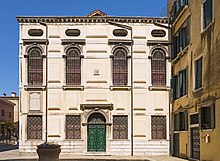Levantine Synagogue
| Levantine Synagogue | |
|---|---|
Scola Levantina | |
 | |
| Religion | |
| Affiliation | Judaism |
| Region | Veneto |
| Rite | Sephardic |
| Year consecrated | 1541 |
| Location | |
| Municipality | Venice |
| Country | Italy |
| Geographic coordinates | 45°26′41″N 12°19′32″E / 45.44472°N 12.32556°E |
| Architecture | |
| Architect(s) | Baldassare Longhena and Andrea Brustolon |
| Style | Baroque |
The Levantine Synagogue (Italian: Scola Levantina, or Sinagoga Scuola Levantina), is a 16th-century Sephardic synagogue located in Venice, Italy.[1]
History[edit]
The synagogue was founded in 1541, and underwent total reconstruction about a century later.[2] It is believed that architect Baldassare Longhena worked on the exterior of the building, and Andrea Brustolon on the interior, specifically the pulpit.[3] The Levantine Synagogue is so named due to its founders being Eastern Sephardim from the Ottoman Empire as well as the Venetian colony of Corfu in what is now Greece. The ancestors of these Levantine Jews were originally from Portugal and Spain.[4][5]
Description[edit]
The design of the synagogue is reminiscient of the Venetian Ghetto in the Cannaregio sestieri. The presence of the building is inconspicuous, as it is not well-accentuated on the outside.[clarification needed] Only the windows, which are larger than a typical building's, stand out as different than the average dwelling, although the inside is far more intricate than the outside.[2]
The synagogue is located in the Campiellio de le Scuole area of the Ghetto.[6] Many external details are typical of Longhena's work, with a prominence of entablatures and volutes in the keystone, mirrored walls, the ashlar plinth, ovulate windows in the attic, and the doors' intricately carved decorations.[7]

In contrast to the exterior, the interior is rich and refined. The floor contains the scola luzzatto, normally used as a study. Up the steps on the bimah, adorned with Solomonic columns with floral decorations, is the rabbi's lectern. The pulpit floor leads to three windows. Opposite to the bimah is the Aron haQodesh, engraved with the Ten Commandments, with the Hebrew date 5542, corresponding to the year 1782.[6] A mechitza is visible and separates the higher women's gallery from the men's. On both sides, a boiserie covers the walls, depicting biblical narratives.[8]
References[edit]
- ^ Touring Club Italiano (2005). Touring club italiano - Gruppo editoriale L'Espresso (ed.). Venezia (in Italian). Vol. 5. Milano - Rome: Biblioteca di Repubblica, Italia. OCLC 799224309.
- ^ a b "Le sinagoghe sono l'anima del ghetto". Museo Ebraico de Venezia. Archived from the original on 2018-06-28. Retrieved 5 Jul 2023.
- ^ "Scuola Levantina". www.italia-ebraica.it (in Italian). Retrieved 2023-07-06.
- ^ "Venice's frayed, shrinking 500-year-old Jewish Ghetto is planning a renaissance". The Times of Israel. Retrieved 2023-12-29.
- ^ "Scuola Levantina in the Jewish Ghetto of Venice". Save Venice Inc. Retrieved 2023-12-29.
- ^ a b "Scola Levantina". jvenice.org (in Italian). Archived from the original on 2019-06-26. Retrieved 5 Jul 2023.
- ^ Bassi, Elena (1962). Edizioni Scientifiche Italiane (ed.). Architettura del Sei e Settecento a Venezia (in Italian). Naples. p. 118.
{{cite book}}: CS1 maint: location missing publisher (link) - ^ "Scola Canton". Visit Jewish Italy (in Italian). Retrieved 2023-07-06.
External links[edit]
 Media related to Scola levantina (Venice) at Wikimedia Commons
Media related to Scola levantina (Venice) at Wikimedia Commons
- Synagogues in Venice
- Sephardi Jewish culture in Italy
- Sephardi synagogues
- Baroque synagogues
- 16th-century synagogues
- 1541 establishments in Europe
- Religious buildings and structures completed in 1541
- 1540s establishments in the Republic of Venice
- Baldassare Longhena buildings
- Greek-Jewish diaspora
- Middle Eastern-Jewish diaspora
- Portuguese-Jewish diaspora in Europe
- Spanish-Jewish diaspora in Europe
- Turkish-Jewish diaspora
